David S. Ferriero's Blog, page 2
February 4, 2022
Catalog Contributions: Celebrating the “Wisdom of the Crowd”
In 2011, we introduced the tagging feature in the National Archives Catalog as a way to invite citizens to contribute their knowledge and expertise to archival descriptions: the “Wisdom of the Crowd.” Within the first month, we celebrated more than 1,000 user-contributed tags; each added with the goal of enhancing records and helping to improve search results.
Thanks to the continued work of more than 29,000 contributors in our citizen archivist community, now, just over 10 years later, we have more than 8 million enhancements on 2.48 million pages of records in the Catalog. Those enhancements include more than 6 million tags and 2 million transcriptions. All of these contributions help improve search results for our records and make handwritten or difficult-to-read text accessible for a wider audience.
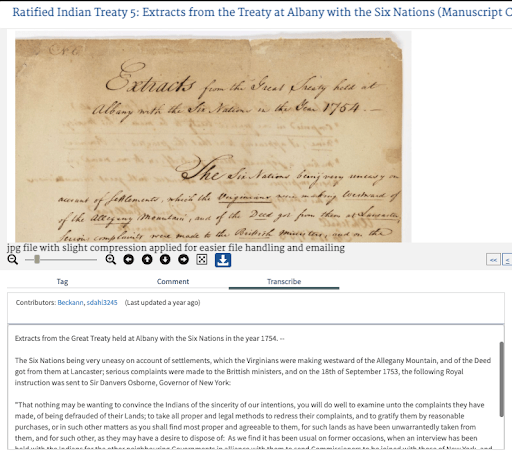 Citizen contributed transcription of Ratified Indian Treaty 5: Extracts from the Treaty at Albany with the Six Nations (Manuscript Copy), 1754.
National Archives Identifier 77166047
Citizen contributed transcription of Ratified Indian Treaty 5: Extracts from the Treaty at Albany with the Six Nations (Manuscript Copy), 1754.
National Archives Identifier 77166047
Contributions to the records in our Catalog have been used for a variety of research tools and search strategies, such as the Bureau of Indian Affairs Finding Aid and the Native American Treaties Explorer, as well as projects organized by NARA staff to help improve access to records, like the Searchable Stock Shots project from the Motion Picture Preservation Lab and the African American History research portals.
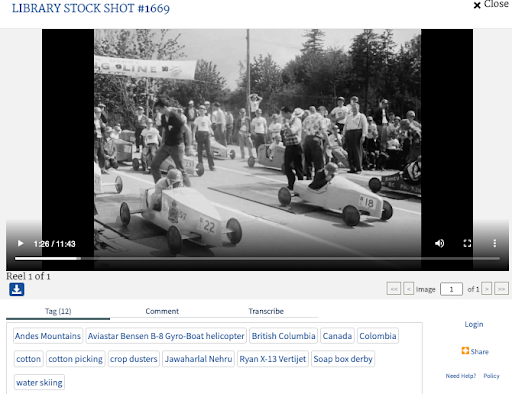 Footage of soap box derby, with descriptive keyword tags added in the Catalog. Still from 306-LS-1669,
National Archives Identifier 58263
.
Footage of soap box derby, with descriptive keyword tags added in the Catalog. Still from 306-LS-1669,
National Archives Identifier 58263
.
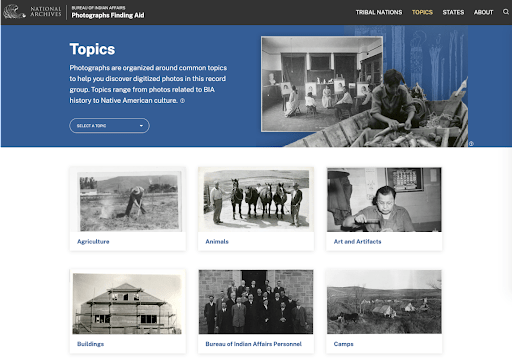 Citizen Archivists tagged photographs with topical subject tags to help contribute to the Topics page of the
Bureau of Indian Affairs Photograph Finding Aid
Citizen Archivists tagged photographs with topical subject tags to help contribute to the Topics page of the
Bureau of Indian Affairs Photograph Finding Aid
The National Archives Catalog contains nearly 28 million descriptions of archival records and more than 165 million digital objects. Millions of digital objects are added to the Catalog every year. With the size of NARA’s publicly available holdings in the Catalog growing each week, facilitating access and discovery to the material in the Catalog is paramount to achieving NARA’s Strategic Goals.
As we work to make more of our holdings available online, it is also important to see how our researchers and customers interact with those records, invite them to contribute their unique knowledge and expertise, and ultimately make the records more searchable and accessible.

Read more about the Citizen Archivist program, including how to register to start tagging and transcribing records, and explore the ongoing citizen archivist missions and more resources for our virtual volunteers.
Many thanks to the more than 29,000 contributors who have helped unlock history. Here are our top 10 contributors:
Transcriptions:
SmithalGypsiTrumanvolLcahalanCmcutronaDdoernerGarywysockiMtarabulskiRCrawfordRonnaBTags:
TmccolleJammon49WWEBERAapiaomONEILLScludwigCassoneIrakirshenbaumLcahalanSmithalJanuary 28, 2022
NARA Staff Collaborate for Improved Access to the 1950 Census
An enumeration district (ED), as used by the Bureau of the Census, was an area that could be covered by a single enumerator (census taker) in one census period. Enumeration districts varied in size from several city blocks in densely populated urban areas to an entire county equivalent in sparsely populated rural areas.
During the design of the 1950 Census website, several stakeholders requested that the search results include the display of the 1950 Census enumeration district descriptions. The enumeration district descriptions, coupled with the enumeration district maps, help researchers to identify which population schedules are relevant to their research.
The image below shows a result from the soon to be released 1950 Census website. The 1950 Census website, currently in development, will be released to the public on April 1, 2022. The search result is for enumeration district 16-20 in Montgomery County, Maryland. There are 46 pages of population schedules. The enumeration district description describes the boundaries of enumeration district 16-20. The maps, accessible by clicking the ED Maps button, include postal route maps, General Land Office maps, soil survey maps, and maps produced by city, county, and state government offices as well as commercial printers. Census officials then drew the enumeration district boundaries and numbers on the base maps.
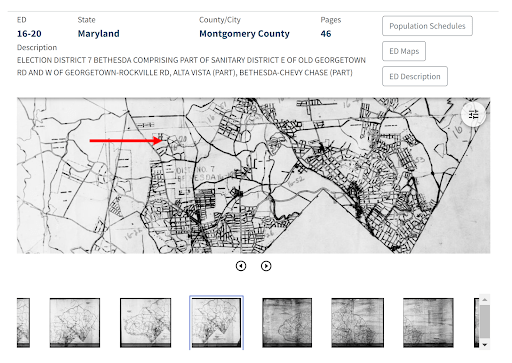
Users will also be able to click on the ED Description button to view the digitized image of the Enumeration district description.
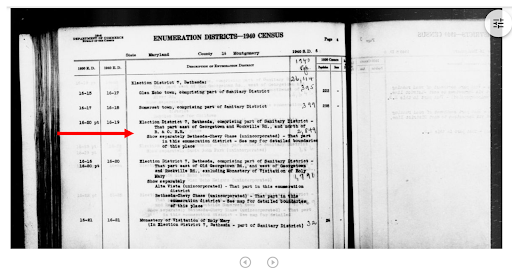
NARA staff digitized over 62,000 pages of 1950 Census enumeration district descriptions. The Office of Innovation processed the images with Amazon’s Textract tool, which resulted in OCR output representing 234,447 enumeration district descriptions. The Textract output was organized into spreadsheets by state/territory and more than 25 NARA staff across the agency are now in the process of cleaning up and formatting the OCR output for display on the 1950 Census website. The project is scheduled to be completed at the end of February. To date, NARA staff have completed the cleanup and formatting of the OCR output of more than 100,000 enumeration district descriptions.
I am proud of the staff from across the agency who have volunteered to collaborate on improving the enumeration district descriptions. They are all motivated to make access happen and to improve the customer experience for the 1950 Census.
Displaying the enumeration district data text in search results on the 1950 Census website will assist researchers in determining which population schedules are relevant to their research. Adding the text also improves accessibility to the enumeration district descriptions for the visually impaired. The digitized images will be accessible in the National Archives Catalog and the enumeration district description images and text will be available for bulk download as part of the full 1950 Census dataset on Amazon’s Open Data Platform in a way that encourages development of websites and applications that present census data in a myriad of ways that the public can use.
January 18, 2022
Guiding Principles for Reparative Description
In keeping with the recommendations from my Task Force on Racism, NARA chartered the Reparative Description and Digitization Working Group in July of 2021. Since then, the Working Group has been reviewing guidance, standards, and processes relating to reparative archival description as well as benchmarking the work of peer institutions. Yale University Library notes that reparative archival description “aims to remediate or contextualize potentially outdated or harmful language used in archival description and to create archival description that is accurate, inclusive, and community-centered.” Recently, the Working Group developed Guiding Principles for Reparative Description at NARA.
These principles will guide the efforts of the Working Group as they begin to draft agency guidance for identifying and updating harmful language in current Catalog descriptions and authority records, and for agency-wide reparative descriptive practices going forward. NARA’s reparative description efforts are in keeping with the efforts of numerous other institutions in the archival community. Library and Archives Canada addresses reparative description in action item 17 of their Indigenous Heritage Action Plan. Reparative description is discussed throughout the Society of American Archivists archival description blog: Descriptive Notes. The University Archives and Special Collections in the Healy Library at the University of Massachusetts Boston posted a statement on reparative description. The Princeton University Library hosts a description working group to describe collections respectfully. Tufts University provides a listing of additional reading on this issue. The Cataloging Lab provides a long list of statements on bias in library and archives description. These are just a few examples of the many archives that are focusing on reparative description. I am proud that NARA is one among them.
January 13, 2022
Retirement of Archivist David S. Ferriero

After 12 years as the tenth Archivist of the United States, I have decided to retire, effective mid-April 2022.
As I wrote to President Biden, it has been the honor of a lifetime to serve my country once more, this time to lead the Executive Branch agency charged with ensuring that the American people can hold their government accountable and learn from the past by accessing the records of our country. My time at the National Archives and Records Administration has been filled with opportunities, challenges, and awesome responsibilities. Over the past several months, as I contemplated retirement and reflected, I am humbled and awestruck and so deeply grateful to the staff, partners, stakeholders, and you, the customers we serve.
I’m extraordinarily proud of what we have accomplished together during my tenure and hope that you too take pride in our efforts and results. We have become a leader in the government’s transition to a digital future, electronic records management, and the principles of Open Government. We’ve served you, our customers, in new and innovative ways, including increasing public access and engagement through the online catalog and social media; streamlining how we serve veterans; expanding access to museums, exhibits, and public programs in person and virtually; and establishing civic literacy initiatives. We’ve fostered strong relationships with partner organizations, and increased outreach to traditional and new stakeholders. Throughout, we’ve put the customer at the center of all that we do.
It is not easy to leave the National Archives with so much exciting work in progress. However, this profession is one of stewardship, where despite our enduring responsibilities, we are here for what amounts to a brief period of time. The National Archives has come a long way since 1934, and we have made great strides in the last 12 years, but the need for thoughtful and deliberate progress and transformation remains. As the Archivist of the United States, I know that the staff, partners, stakeholders, and our customers will build on our work together in ways I cannot imagine; as a citizen and veteran, I am thankful for those who will continue the noble work of the National Archives and Records Administration with skill, passion, and resiliency.
Deputy Archivist Debra Steidel Wall will serve as Acting Archivist until the President nominates and the Senate confirms my successor.
It’s been a privilege to work on your behalf. The strength and success of our organization would not be possible without your support and dedication to the National Archives’ mission. I wish you all the very best for the future and remarkable personal and professional success in the years ahead.
Sincerely,
DAVID S. FERRIERO
Archivist of the United States
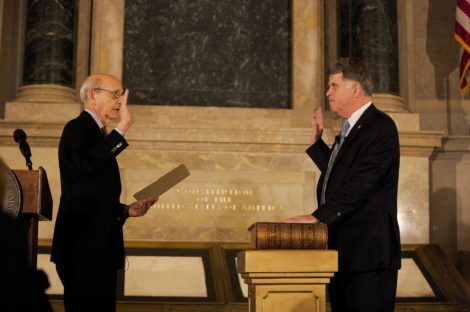 Formal Swearing In Ceremony of David Ferriero, 10th Archivist of the United States. U.S. Supreme Court Justice Stephen Breyer and David S. Ferriero, 1/13,2010. National Archives Identifier 210375533
Formal Swearing In Ceremony of David Ferriero, 10th Archivist of the United States. U.S. Supreme Court Justice Stephen Breyer and David S. Ferriero, 1/13,2010. National Archives Identifier 210375533
December 7, 2021
Leadership Changes to Advance Equity
In order to advance equity and integrate the principles of Diversity, Equity, Inclusion, and Accessibility (DEIA) into our agency’s decision-making, I have created two new leadership positions at NARA, the Chief Equity Officer and the Chief Diversity Officer.
The Chief Equity Officer is a newly-created position in the Senior Executive Service that will report directly to me. The Chief Equity Officer will lead continuous engagement with underserved communities to better understand their needs for NARA services; serve as an ombudsperson to receive suggestions and complaints from customers when our services do not meet our ideals for equity; and promote equity in management decision-making and regulatory processes. The Chief Equity Officer will hold a seat on the Executive Leadership Team as well as NARA’s Management Team.
The Chief Diversity Officer is a new responsibility assigned to the Office of Human Capital. The Chief Diversity Officer is responsible for using a data-driven approach to assess and ensure that NARA employment practices are equitable, especially in the areas of: recruitment, hiring, promotion, retention, professional development, performance evaluations, pay and compensation policies, and training policies and practices are equitable. The Chief Diversity Officer will hold a seat on NARA’s Management Team.
We are also embedding the principles of equity and DEIA in NARA’s Strategic Plan. NARA’s Management Team has added two new values and one new transformational outcome to reaffirm our commitment to equity and DEIA. The values are:
Act with Integrity: Build trust by acting with honesty, fairness, and transparency. Advance Diversity: Model diversity, inclusion, equity, and accessibility throughout the agency and expand participation by staff and customers of all backgrounds in NARA programs and decision-making.Transformational Outcome:
A Diverse and Inclusive NARA: We will embrace diversity, equity, inclusion, and accessibility so that our workforce and our customers of all backgrounds are valued and supported.These actions are an important step in our goal to embed equity in all of our decision-making processes; to signal our commitment to these principles as a strategic imperative; and to support two important Administration priorities: Executive Order 13985: Advancing Racial Equity and Support for Underserved Communities Through the Federal Government and Executive Order 14035: Diversity, Equity, Inclusion, and Accessibility in the Federal Workforce. I appreciate NARA’s senior leaders for their commitment to a diverse and equitable NARA, and look forward to working with these new leaders to create a stronger future together.
November 12, 2021
Celebrating 150 Million Digital Copies in the Catalog, Part 4: Highlights from the Presidential Libraries
Thanks to the persistence and dedication of many NARA staff and the help of our partners, the number of digital copies of our records in the National Archives Catalog surpassed 150 million. Digitizing large quantities of our records is an important goal for NARA because we know that not everyone can come to our facilities and providing these records online democratizes access to them. The conditions of the pandemic helped us to further understand the importance of providing digital access to our records.
NARA has prioritized many of the records for scanning based on the records that have been most often requested by our researchers. So although digital copies account for only a fraction of the total number of records in our custody, we know that these records are some of the most heavily used by our researchers.
In celebration of exceeding 150 million digital copies in the Catalog, we are highlighting some of the records from our Presidential Libraries that you may not have seen and are now available in NARA’s Catalog.
Meredith Evans, Director of the Jimmy Carter Presidential Library and Museum, notes that the Library digitized some of Carter’s Chief of Staff Hamilton Jordan’s Confidential Files earlier this year. These files are frequently requested. The file: Administration Review, Goals and Priorities File, First Draft of December 1977 is an interesting mix of semi-candid reflection and political maneuvering and a rare glimpse at the thought processes behind an administration.
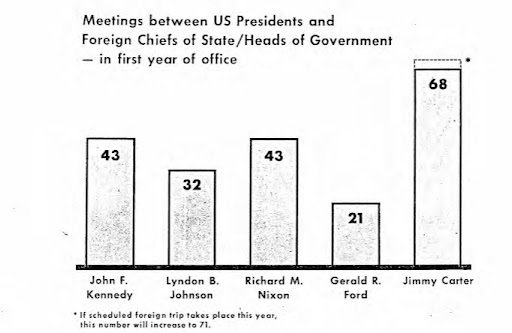 Administration Review, Goals and Priorities – First Draft of December 1977 – Memo. National Archives Identifier 142101
Administration Review, Goals and Priorities – First Draft of December 1977 – Memo. National Archives Identifier 142101Kirsten Strigel Carter, Supervisory Archivist at the Franklin D. Roosevelt Presidential Library and Museum, says that their staff added many digital copies of Roosevelt photos to the Catalog this year, including “Franklin D. Roosevelt in the Gondola of a Dirigible.”
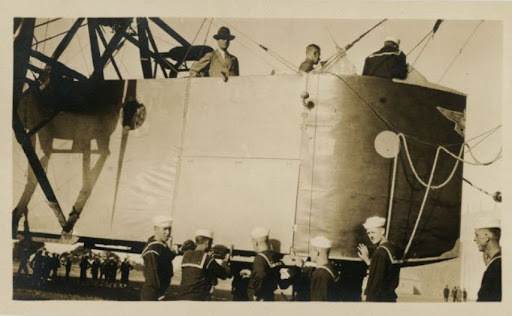 Franklin D. Roosevelt in the Gondola of a Dirigible, 8/17/1918. National Archives Identifier 196067436
Franklin D. Roosevelt in the Gondola of a Dirigible, 8/17/1918. National Archives Identifier 196067436The photo shows FDR aboard the gondola of a floating airship during World War I. He was Assistant Secretary of the Navy at the time, touring Allied bases in Europe in 1918. This image may capture the moment he became the first (future) US President to fly in a dirigible aircraft, though we aren’t certain that he is in fact the first. We posed the question to the public a few years ago: https://fdr.blogs.archives.gov/2012/01/05/found-in-the-archives-24/.
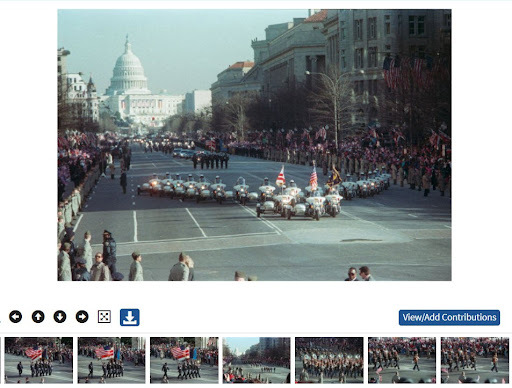 Inaugural Parade Contact Sheet. National Archives Identifier 176254098
Inaugural Parade Contact Sheet. National Archives Identifier 176254098Dana Simmons, Supervisory Archivist at the William J. Clinton Presidential Library and Museum, reports that staff worked hard to get all of the contact sheet descriptions as well as digital images associated with the 1993 Inaugural festivities including the ceremony, parade, luncheons, and inaugural balls, and more, into the Catalog during the pandemic. These images depict the excitement and promise of a new Presidential Administration. Approximately 100 inaugural-related contact sheets from 1993 were described and uploaded to the Catalog during the pandemic.
Tammy K. Williams, Archivist and Social Media Coordinator for the Harry S. Truman Presidential Library and Museum, notes that digital copies from the Truman Library have topped 100,000 in the Catalog this year. The Library continues to add more of Truman’s handwritten materials in the Catalog so they can be transcribed.
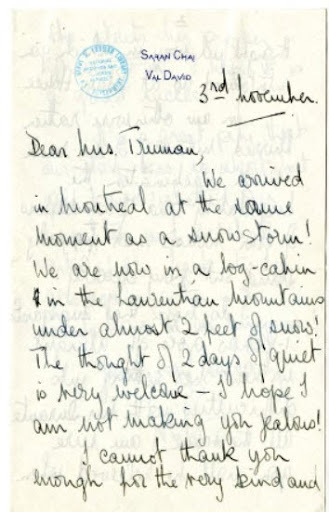 Letter from Prince Philip, Duke of Edinburgh, to First Lady Bess W. Truman, 11/3/1951. National Archives Identifier 210023705
Letter from Prince Philip, Duke of Edinburgh, to First Lady Bess W. Truman, 11/3/1951. National Archives Identifier 210023705This letter was digitized in the wake of the Duke’s death earlier this year. He wrote it to Mrs. Truman after he and Princess Elizabeth made their first visit to the United States. On page two of this letter, he wrote: “It is a great pity that our stay was so short but you have whetted our appetites and we shall certainly be back to see you again either in the White House or in Mizzoura!” He meant to write “Missouri,” but it’s highly likely that the Duke might not have been familiar with the spelling of Missouri, and wrote it how the Trumans (and many other Missourians) pronounce the name of our state.
 Memorandum of Conversation Regarding Bermuda Meeting, 12/4/1953. National Archives Identifier 12022750
Memorandum of Conversation Regarding Bermuda Meeting, 12/4/1953. National Archives Identifier 12022750Dawn Hammett, Director of the Eisenhower Presidential Library, notes that Eisenhower talked a great deal about the importance of the Bermuda Meeting in his book “Mandate for Change,” including changes regarding the French and Italian governments, the rebuke of European Defence Community by the French due to the sticking point of admitting West Germany into it, the eventual reconciliation of admitting West Germany into NATO, and the French problems in Indochina.
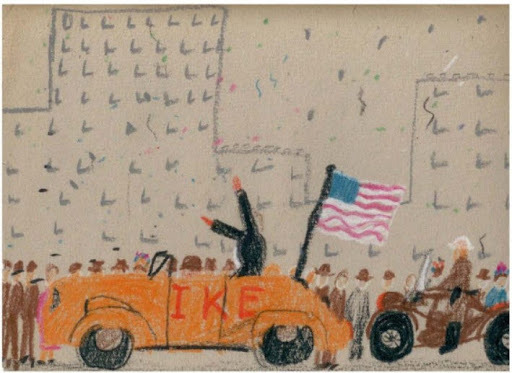 Drawing of the 1953 Inaugural Parade. National Archives Identifier 6919109
Drawing of the 1953 Inaugural Parade. National Archives Identifier 6919109The Catalog also holds a wide-variety of images from the Eisenhower Library, including:
Photograph of the USS Shenandoah moored to USS Patoka, Hawaiian Airlines Ticket Envelope, and a Photograph of a Girl Roller-Skating.
The Lyndon Baines Johnson Presidential Library staff provided 3,842 audio files of LBJ’s telephone conversations for the Catalog this year. Jennifer Cuddeback, supervisory archivist, notes that through the conversations, we can intimately experience the Johnson presidency “with the bark off.” We hear for ourselves his sorrows and successes as he negotiates, cajoles, celebrates and laments with his friends, family, advisers and adversaries to formulate his policies and drive his agenda forward. The White House Telephone Recordings and Transcripts (National Archives Identifier 187903) are described at https://catalog.archives.gov/id/187903.
LBJ Recording of Telephone Conversation, WH Series, Speaker: JOHN WHEELER, Time: 6:40P. National Archives Identifier 187923
 “The Common Chiffchaff.” National Archives Identifier 219756197
“The Common Chiffchaff.” National Archives Identifier 219756197Erin McKeen, Collections manager and Registrar at the Barack Obama Presidential Library, tells us that this artifact was gifted to President Obama by Sheikh Tamim bin Hamad Al Thani, the Emir of Qatar during the U.S.- Gulf Cooperation Council Meeting in May 2015. The gold-plated bird clock mechanism tweets, turns, and flaps its wings once per hour. The mechanical bird, made by music box atelier Reuge of Sainte-Croix, Switzerland, is modeled after a common chiffchaff, or warbler. The back panel of the box lifts to access the 15 mechanical automatons made up of 500 individually-made pieces. Etched into the back is text about the Islamic Golden Age and the bird was created to honor the scholar and polymath Ismail al-Jazari.
This series of blogposts, celebrating over 150 million digital copies in the National Archives Catalog, provides you with just a glimpse of the wide variety of records documenting American history that are held by the National Archives, including the records held by our Presidential Libraries. As we continue to digitize our records, we are also ensuring that the technology for the Catalog will continue to scale to meet the vastness of our holdings.
My thanks to staff who contributed to this post, including:
Meredith Evans, Director of the Jimmy Carter Presidential Library and Museum
Kirsten Strigel Carter, Supervisory Archivist, Franklin D. Roosevelt Presidential Library and Museum
Tammy K. Williams, Archivist and Social Media Coordinator, Harry S. Truman Presidential Library and Museum
Dana Simmons, Supervisory Archivist, William J. Clinton Presidential Library and Museum
Jennifer Cuddeback, Supervisory Archivist, Lyndon B. Johnson Presidential Library and Museum
Erin McKeen, Collections Manager and Registrar, Barack Obama Presidential Library
Dawn Hammett, Director, Dwight D. Eisenhower Presidential Library and Museum and Boyhood Home
November 10, 2021
Honoring our Veterans
November 11 marks the annual observance of Veterans Day, a day on which we honor the courageous women and men who have served in the United States military.
 Marines come ashore near Da Nang Air Base on March 8, 1965. (National Archives, RG 127; National Archives Identifier 26382181)
Marines come ashore near Da Nang Air Base on March 8, 1965. (National Archives, RG 127; National Archives Identifier 26382181)The National Archives is proud to have in its holdings a variety of military records, from photos to documents to searchable databases, which are available on National Archives News. NARA’s holdings regarding veterans and military records include:
Veterans’ Service RecordsGenealogy Research in Military RecordsAmerican RevolutionCivil War RecordsWorld War I and World War II RecordsI am proud of the daily work the National Archives performs on behalf of those who have served and continue to serve our nation in the United States military, as well as their families. The National Personnel Records Center (NPRC) in St. Louis, MO, is central to this work serving our veterans and their families. Our mission to provide world-class customer service enables veterans and their families access to the records they need to obtain essential benefits and services owed to them because of their service and sacrifice. I am particularly proud of the NPRC and the National Archives at St. Louis staff who have supported them. Their tireless and extraordinary efforts to accomplish this essential mission throughout the pandemic has truly exemplified the best of NARA values.
Today we held the 6th Annual Veterans Day program for NARA staff, hosted by IKE, NARA’s Veterans Employee Affinity Group. We welcomed Cybele Merrick from the Department of Veterans Affairs as our keynote speaker who spoke on post-traumatic stress disorder and the resources available for veterans, including these video resources for the public and veterans about PTSD and effective treatments.
 U.S. Department of Veterans Affairs,
National Center for PTSD educational whiteboard videos
for the Public and Veterans.
U.S. Department of Veterans Affairs,
National Center for PTSD educational whiteboard videos
for the Public and Veterans.I also offered the following remarks during the Veterans Day Program:
Greetings from Washington. Thanks to the 563 NARA employees who are Veterans. We represent almost 20% of the workforce and I am proud to be one of you.
Thanks also to those many staff members who provide services to our Veterans. Special thanks to those staff volunteers who have been fulfilling emergency requests at NPRC. I hope you all share the pride that I feel knowing we are making a difference in the lives of those who have sacrificed so much for our country.
Every day, thanks to the persistence and dedication of our staff, miracles are performed in connecting veterans and their families with the records they need to receive benefits: burials, medical assistance, housing for homeless vets, among the top needs presented.
Even in a pandemic environment, since we shut down in March of 2020, staff volunteers have responded to almost half a million VA requests. In addition, those volunteers also enabled 88,000 burials, housing for 20,000 veterans, 51,000 medical emergency treatment for 51,000 vets, and other needs for a grand total of 546,000 responses. On behalf of the Veteran community, thank you. Thank you for your selfless service.
Today’s IKE program delivers a timely message on how the Veterans Administration’s National Center for Post-Traumatic Stress Disorder addresses the many issues related to PTSD among Vets. I say “timely” because as you will hear or already know, PTSD symptoms are not owned by Vets alone. Many of us, over the past 17 months have experienced symptoms in one form or another.
As a former Navy Hospital Corpsman with a PsychTech MOS, I treated sailors and marines exhibiting disorder symptoms stateside and in Vietnam. My training at Bethesda Naval Hospital and St. Elizabeth’s Hospital educated me about the stressors, how they are manifested, and how they can be neutralized. That training was many, many years ago, but is still very much part of who I am today. Today’s message from Cybele Merrick will serve us all well in recognizing PTSD in ourselves and those around us.
Thank you for joining us today.
Let us honor those men and women who have served in our Armed Forces and continue to serve. Thank you for your service.
November 3, 2021
Celebrating 150 Million Digital Copies in the Catalog, Part Three
Thanks to the persistence and dedication of many NARA staff and the help of our partners, the number of digital copies of our records in the National Archives Catalog surpassed 150 million. Digitizing large quantities of our records is an important goal for NARA because we know that not everyone can come to our facilities and providing these records online democratizes access to them. The conditions of the pandemic helped us to further understand the importance of providing digital access to our records.
NARA has prioritized many of the records for scanning based on the records that have been most often requested by our researchers. So although digital copies account for only a fraction of the total number of records in our custody, we know that these are some of the most heavily used by our researchers.
In celebration of exceeding 150 million digital copies, we are highlighting some interesting records that you may not know are available in NARA’s Catalog. The following photos are from over 43,000 Photographic Negatives 1939-1984. These uncaptioned photographs are from the records of the Bonneville Power Administration.
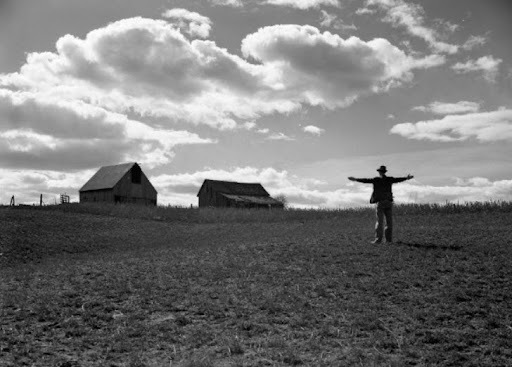 Records of the Bonneville Power Administration, 1936 – 2006, E7867. National Archives Identifier 178298632
Records of the Bonneville Power Administration, 1936 – 2006, E7867. National Archives Identifier 178298632
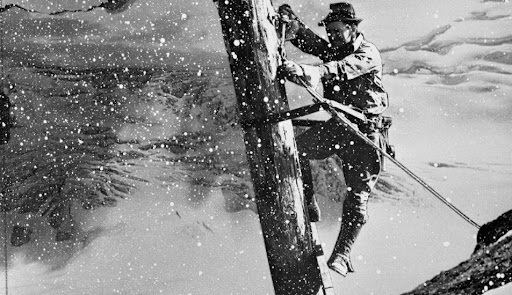 Records of the Bonneville Power Administration, 1936 – 2006, E4464. National Archives Identifier 177403042
Records of the Bonneville Power Administration, 1936 – 2006, E4464. National Archives Identifier 177403042
 Records of the Bonneville Power Administration, 1936 – 2006, E3570. National Archives Identifier 177401263
Records of the Bonneville Power Administration, 1936 – 2006, E3570. National Archives Identifier 177401263
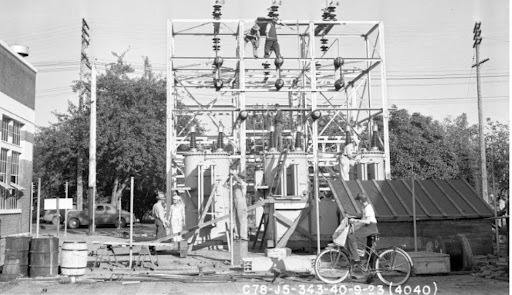 Records of the Bonneville Power Administration, 1936 – 2006, E4040. National Archives Identifier 177402194. Oregonian Newspaper Delivery is unassuming but has so much detail the more you examine it. Click on the link to zoom in on the photo.
Records of the Bonneville Power Administration, 1936 – 2006, E4040. National Archives Identifier 177402194. Oregonian Newspaper Delivery is unassuming but has so much detail the more you examine it. Click on the link to zoom in on the photo.
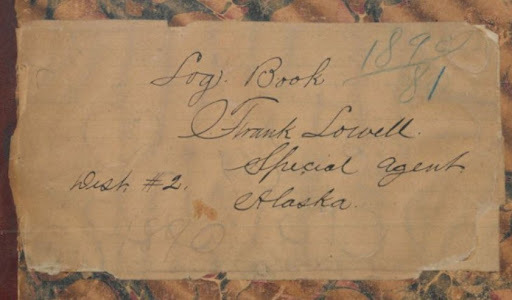 Logbook of Frank Lowell, Special Agent, Alaska District No., 2, 1890 Census
, National Archives Identifier 202288465. This is a fragment of the 1890 Census for Alaska (see the full story in NARA’s
Text Message blog
)
Logbook of Frank Lowell, Special Agent, Alaska District No., 2, 1890 Census
, National Archives Identifier 202288465. This is a fragment of the 1890 Census for Alaska (see the full story in NARA’s
Text Message blog
)
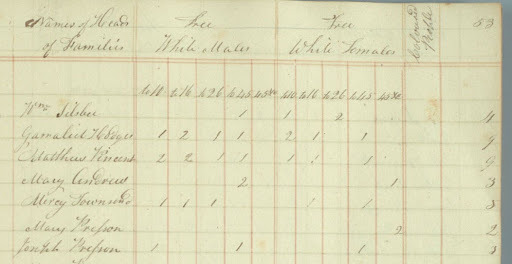 1810 Census of Salem, Essex County, Massachusetts
, National Archives Identifier 205601220. These records were alienated from Federal custody and in the possession of Peabody Essex Museum until they were recovered and returned to NARA in April 2021.
1810 Census of Salem, Essex County, Massachusetts
, National Archives Identifier 205601220. These records were alienated from Federal custody and in the possession of Peabody Essex Museum until they were recovered and returned to NARA in April 2021.
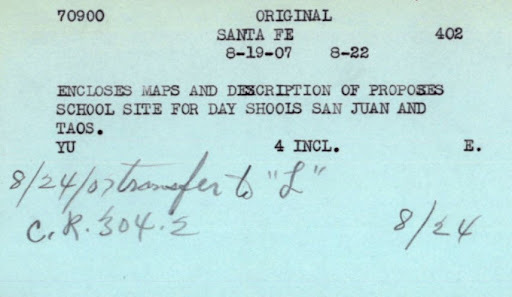 Useful for researchers looking in the BIA Central Classified files:
Numerical Index to the Central Classified Files
, 1907-1942 – National Archives Identifier 2108754, BIA index (ongoing).
Useful for researchers looking in the BIA Central Classified files:
Numerical Index to the Central Classified Files
, 1907-1942 – National Archives Identifier 2108754, BIA index (ongoing).
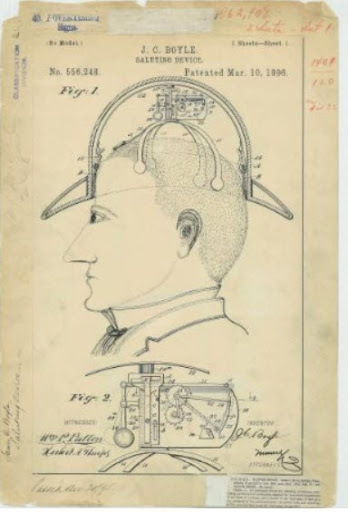 Patent Drawing for J. C. Noyles’ Saluting Device
, National Archives Identifier 18558024. From
Utility Patent Drawings
(ongoing)
Patent Drawing for J. C. Noyles’ Saluting Device
, National Archives Identifier 18558024. From
Utility Patent Drawings
(ongoing)My thanks to the staff at the National Archives in Seattle, as well as the Digitization Division and the Cartographic Branch at our College Park Archives for sharing a few of the many interesting records that we hold at the National Archives and make available through our online Catalog.
November 1, 2021
Celebrating 150 Million Digital Copies in the Catalog, Part Two
In my last post, I noted that through the persistence and dedication of many NARA staff and the help of our partners, the number of digital copies of our records in the National Archives Catalog surpassed 150 million. Digitizing large quantities of our records is an important goal for NARA because we know that not everyone can come to our facilities and providing these records online democratizes access to them. The conditions of the pandemic helped us to further understand the importance of providing digital access to our records.
NARA has prioritized many of the records for scanning based on the records that have been most often requested by our researchers. So although digital copies account for only a fraction of the total number of records in our custody, we know that these are some of the most heavily used by our researchers.
In celebration of exceeding 150 million digital copies, I offer highlights of some of the records that are now available in NARA’s Catalog.
 Photograph of a Marine Returning to a Coast Guard-Manned Assault Transport
National Archives Identifier 51302
from 14,081 prints from
U.S. Coast Guard Photographs of Activities, Facilities, and Personalities, 1939-1967
– National Archives Identifier 513164 / 26-G. These include D-Day photos.
Photograph of a Marine Returning to a Coast Guard-Manned Assault Transport
National Archives Identifier 51302
from 14,081 prints from
U.S. Coast Guard Photographs of Activities, Facilities, and Personalities, 1939-1967
– National Archives Identifier 513164 / 26-G. These include D-Day photos.The “Mascots” file in this series contains great animal photos:
 “Dee-Day” Goes to France on D-Day . National Archives Identifier 205583066
“Dee-Day” Goes to France on D-Day . National Archives Identifier 205583066
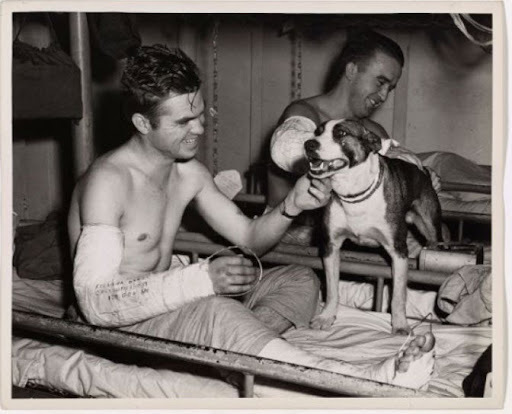 “Doc Sunshine” Makes His Rounds. National Archives Identifier 205582889
“Doc Sunshine” Makes His Rounds. National Archives Identifier 205582889See also:
“Good Luck” Mutt Goes Along on the Invasion, National Archives Identifier 205582913Ship’s Pup Looks Right Smart at Deck Muster, National Archives Identifier 205582925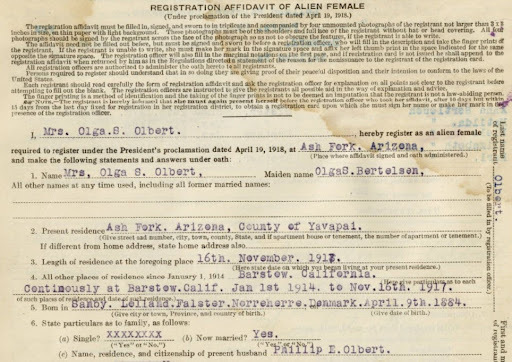 Alien Registration Affidavit for Olga S. Olbert, National Archives Identifier 217848343. From the series Alien Registration Affidavits, 1918
Alien Registration Affidavit for Olga S. Olbert, National Archives Identifier 217848343. From the series Alien Registration Affidavits, 1918
 Chinese Exclusion Act Case File 2500/10: Jon Kim — 1911–[INS Office] Boston, National Archives Identifier 7798167 from Chinese Exclusion Act Case Files
Chinese Exclusion Act Case File 2500/10: Jon Kim — 1911–[INS Office] Boston, National Archives Identifier 7798167 from Chinese Exclusion Act Case FilesThanks to the staff in Riverside, Boston, and our Still Pictures Branch for sharing a few of the many interesting records that we hold at the National Archives and make available through our online Catalog.
October 26, 2021
Celebrating 150 Million Digital Copies in the Catalog
Thanks to the persistence and dedication of many NARA staff and the help of our partners, the number of digital copies of our records in the National Archives Catalog has just surpassed 150 million. Digitizing large quantities of our records is an important goal for NARA because we know that not everyone can come to our facilities. Providing these records online democratizes access to them. The conditions of the pandemic helped us to further understand the importance of providing digital access to our records. I am very proud of the progress that the agency has made from providing less than one million records online a decade ago, to over 150 million records available through our Catalog today. And we plan to keep going.
NARA has prioritized many of the records for scanning based on the records that have been most often requested by our researchers. So although digital copies account for only a fraction of the total number of records in our custody, we know that these are some of the most heavily used by our researchers.
I asked staff to share some of their favorite additions to the Catalog over the past year and I received so many interesting responses that I think you will be interested in, too. I will be sharing their recommendations over the next few blog posts in celebration of our first 150 million.
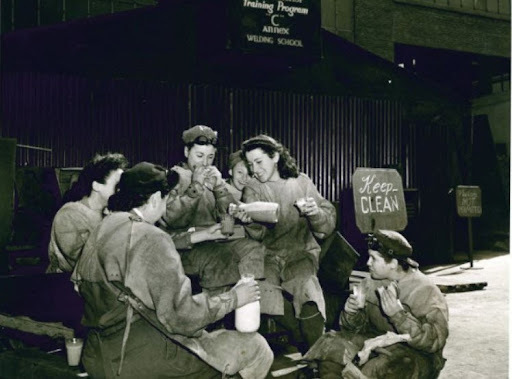 Student Welders Having Lunch
from the file 62.322 – Photographs
Student Welders Having Lunch
from the file 62.322 – PhotographsStaff from the National Archives at New York highlighted RG 211 War Manpower Commission images. There are 13 images in file 62.322 – Photographs, which is from the Regional Central Files series, 1941 – 1946. This file unit contains photographs of women in the workforce. Photographs follow women throughout their work day; women were photographed posing for identification photographs and learning about proper attire, as well as working and relaxing with coworkers. Also included are photographs of farming and farm life, commissioned by the Farm Security Administration, and taken by Russell Lee, Dorthea Lange, Marion Post-Wolcott, and other FSA photographers.
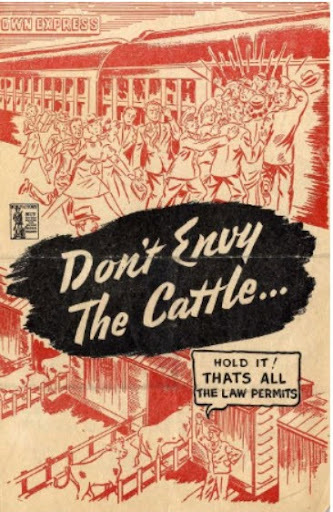 Public transit users will find this relatable:
Don’t Envy the Cattle
from the file
536.27 – Transportation
, Record Group 211 War Manpower Commission
Public transit users will find this relatable:
Don’t Envy the Cattle
from the file
536.27 – Transportation
, Record Group 211 War Manpower Commission
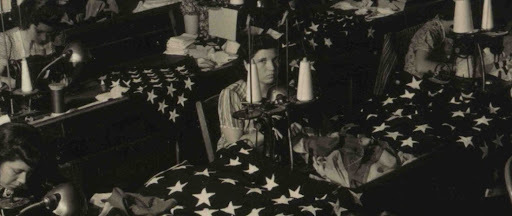 This
Margaret Bourke-White flag making photo
is from the series
General Correspondence, 1896 – 1942
, in Record Group 181
,
Records of Naval Districts and Shore Establishments, 1784 – 2000.
This
Margaret Bourke-White flag making photo
is from the series
General Correspondence, 1896 – 1942
, in Record Group 181
,
Records of Naval Districts and Shore Establishments, 1784 – 2000.
 Depositions from the Case Against the Charles
Depositions from the Case Against the Charles
The Pink Charles case dated 1685 (RG 21 Vice Admiralty, one of our oldest holdings) involving slaves brought ashore in Rye, New York, is interesting. One of the volunteers at the NYC facility pointed it out to her mom during the pandemic, and she went in and did the citizen transcription.
Thanks to the staff in New York for sharing a few of the fascinating records that we hold at the National Archives and make available through our online Catalog.
Do you have a favorite record from the Catalog?
David S. Ferriero's Blog



